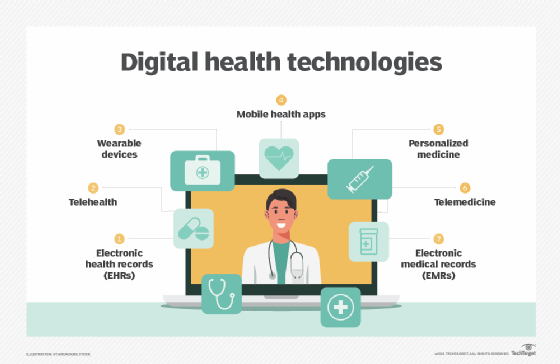point of care (POC) testing
What is point of care (POC) testing?
Point of care testing (POC testing or POCT) is medical testing performed with the patient, outside of a laboratory setting. POC testing is also known as bedside testing, near-patient testing, remote testing, mobile testing and rapid diagnostics. In general, the term can encompass any patient medical test that is given ad hoc and provides quick results. Most POC testing devices are handheld electronics or molecular collection tools. Common examples of POC test tools include blood glucose monitors, thermometers, home pregnancy tests and rapid strep tests.
To address immediate healthcare concerns, POC testing can be carried out in a variety of locations by first responders, radiologists, nurses and other healthcare providers at pharmacies, clinics, ambulances, accident scenes, care facilities and homes. POC testing devices employed remotely enable doctors to see in near real time vital information about their patients, known as remote patient monitoring. It can be used in conjunction with telehealth services to provide at home care.
The implementation of POC testing is useful for value-based healthcare where there is a need for more convenient diagnosis, accurate monitoring, early detection and the prevention and management of chronic conditions. For example, rapid strep tests can allow a patient to receive earlier treatment and avoid further risks associated with misdiagnosis.
The COVID-19 pandemic highlighted the value of POC testing. Laboratory PCR testing was highly accurate, but the high cost and delay of several days for results to become available limited its usefulness. Instead, rapid tests performed as POC tests or as at-home tests were more common.

Point of care testing technology
The proliferation of POC technology is contributing to major changes in healthcare, which is focusing increasingly on better patient outcomes, linking provider reimbursement to quality metrics instead of traditional fee for services, adopting electronic health records and developing accountable care organizations. POC technologies offer the potential to improve the management of various diseases and conditions, particularly in settings where healthcare infrastructure and access to quality and timely medical care are limited.
The use of mobile devices at the point of care is a key driver for improving the quality, accessibility and safety of care, as well as increasing its cost-effectiveness. The adoption of smartphones and other mobile devices by clinicians, consumers and employees is enabling providers, who traditionally have been slow to respond to technology innovation, to bring about major changes in how they work.
Many medical devices for home use can now be connected to the internet or to a smartphone. This allows for remote monitoring or adjusting the devices on the fly by medical professionals. Some devices that can be used this way are continuous blood glucose monitors, insulin pumps, CPAP machines and pacemakers. Some hospitals utilize remote monitoring services. These services have medical professionals monitor patient vitals at another location, then alert the local staff if there are any incidents. Proper cybersecurity is vital as hacking or denial-of-service attacks against medical services could lead to injury or loss of life.
Point of care testing benefits and drawbacks
The portability and accessibility of POC testing devices have brought about several advantages in the healthcare industry. When used properly, these devices can help make medical practices and treatments more efficient, effective and higher quality overall. At home use enables patients to monitor their own conditions more frequently in order to get more consistent results and gain some independence.
At-home and POC testing kits more easily fit into busy lifestyles. They can cut down on the number of doctor's visits and time spent at the doctor's office waiting for test results. The testing and results can be done privately.
POC testing can also combat larger issues such as minimizing emergency room overcrowding, lowering diagnosis and prescription times and streamlining major accident response. The growth of this testing has also been correlated with a reduced need for follow-up visits and wider access to healthcare in remote areas.
However, there are a few drawbacks associated with testing devices that are readily available. When placing healthcare in the patient's hands, instructions need to be followed accurately. The results of certain POC devices lead to major health decisions, such as medication dosage; therefore, patients need to be well educated on device instructions and implications.
Additionally, these medical devices need to be restricted to only the intended use and monitored for misinterpretation or inconsistencies. It is also crucial that POC testing data is properly managed and implemented into the appropriate health records to be most beneficial.
The end user needs to be properly trained to use POC tests. This includes following proper sanitary and specimen collection processes. Testing devices need to be properly stored and used before their expiration date. Many at-home test kits come with video instructions to guide the end user.
Point of care testing vs. laboratory testing
There are several differences between point of care testing and laboratory testing, such as the following:
Laboratory testing
- More accurate.
- Slower results.
- More expensive.
- Needs to be administered by a medical provider.
Point of care testing
- Less accurate.
- Faster results.
- Cheaper.
- Most can be done by anyone.
Learn about EHRs and why they're an important part of health IT. See how IT tools are being used to capture patient health data in real time to transform the healthcare industry.




